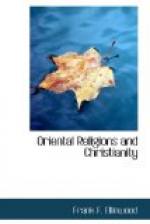5. An account taken by Spence Hardy from Cingalese books of a comparatively modern date.
6. An English translation by Bigandet of a Burmese account, which was itself a translation of unknown date made from a Pali version.
7. An account of the death of Gautama, given in Pali and said to be the oldest of all the sources. It is full of wonders created by the fancy of the unknown author, but differs widely from the fancy sketches of the Lalita Vistara of the North.
8. A translation by Mr. Alabaster of a Siamese account. It does not claim to be exact.]
[Footnote 94: T.W. Rhys Davids illustrates the worthlessness of poetic narrations as grounds of argument by quoting from Milton’s Paradise Regained this mere fancy sketch of the accompaniments of Christ’s temptation:
“And
either tropic now
’Gan thunder and both ends
of heaven; the clouds
From many a horrid rift abortive
poured
Fierce rain with lightning mixed,
water with fire
In ruin reconciled; nor slept the
winds
Within their stony caves, but rush’d
abroad
From the four hinges of the world,
and fell
On the vex’d wilderness; whose
tallest pines
Tho’ rooted deep as high and
sturdiest oaks,
Bowed their stiff necks, loaden
with stormy blasts
Or torn up sheer. Ill wast
Thou shrouded then,
O patient Son of God, yet stood’st
alone
Unshaken! nor yet staid the terror
there;
Infernal ghosts and hellish furies
round
Environed Thee; some howl’d,
some yell’d, some shriek’d,
Some bent at Thee their fiery darts,
while Thou
Sat’st unappall’d in
calm and sinless peace.”
Book
iv.]
[Footnote 95: See National Religion and Universal Religion, p. 362.]
[Footnote 96: Hibbert Lectures, 1882.]
LECTURE VI.
MOHAMMEDANISM PAST AND PRESENT
It has been the fate of every great religious teacher to have his memory enveloped in a haze of posthumous myths. Even the Gospel history was embellished with marvellous apocryphal legends of the childhood of Christ. Buddhism very soon began to be overgrown with a truly Indian luxuriance of fables, miracles, and pre-existent histories extending through five hundred past transmigrations. In like manner, the followers of Mohammed traced the history of their prophet and of their sacred city back to the time of Adam. And Mohammedan legends were not a slow and natural growth, as in the case of most other faiths. There was a set purpose in producing them without much delay. The conquests of Islam over the Eastern empires had been very rapid. The success of Mohammed’s cause and creed had exceeded the expectations of his most sanguine followers. In the first half of the seventh century—nay, between the years 630 and 638 A.D.—Jerusalem, Damascus, and Aleppo had fallen before the arms of Omar and his lieutenant “Khaled the Invincible,” and in 639 Egypt was added to the realm of the Khalifs. Persia was conquered in A.D. 640.




